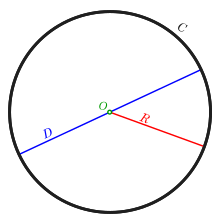
In classical geometry, a radius (pl.: radii or radiuses)[a] of a circle or sphere is any of the line segments from its center to its perimeter, and in more modern usage, it is also their length. The name comes from the Latin radius, meaning ray but also the spoke of a chariot wheel.[2] The typical abbreviation and mathematical variable symbol for radius is R or r. By extension, the diameter D is defined as twice the radius:[3]
If an object does not have a center, the term may refer to its circumradius, the radius of its circumscribed circle or circumscribed sphere. In either case, the radius may be more than half the diameter, which is usually defined as the maximum distance between any two points of the figure. The inradius of a geometric figure is usually the radius of the largest circle or sphere contained in it. The inner radius of a ring, tube or other hollow object is the radius of its cavity.
For regular polygons, the radius is the same as its circumradius.[4] The inradius of a regular polygon is also called apothem. In graph theory, the radius of a graph is the minimum over all vertices u of the maximum distance from u to any other vertex of the graph.[5]
The radius of the circle with perimeter (circumference) C is
- ^ "Radius - Definition and More from the Free Merriam-Webster Dictionary". Merriam-webster.com. Retrieved 2012-05-22.
- ^ Definition of Radius at dictionary.reference.com. Accessed on 2009-08-08.
- ^ Definition of radius at mathwords.com. Accessed on 2009-08-08.
- ^ Barnett Rich, Christopher Thomas (2008), Schaum's Outline of Geometry, 4th edition, 326 pages. McGraw-Hill Professional. ISBN 0-07-154412-7, ISBN 978-0-07-154412-2. Online version accessed on 2009-08-08.
- ^ Jonathan L. Gross, Jay Yellen (2006), Graph theory and its applications. 2nd edition, 779 pages; CRC Press. ISBN 1-58488-505-X, 9781584885054. Online version accessed on 2009-08-08.
Cite error: There are <ref group=lower-alpha> tags or {{efn}} templates on this page, but the references will not show without a {{reflist|group=lower-alpha}} template or {{notelist}} template (see the help page).

